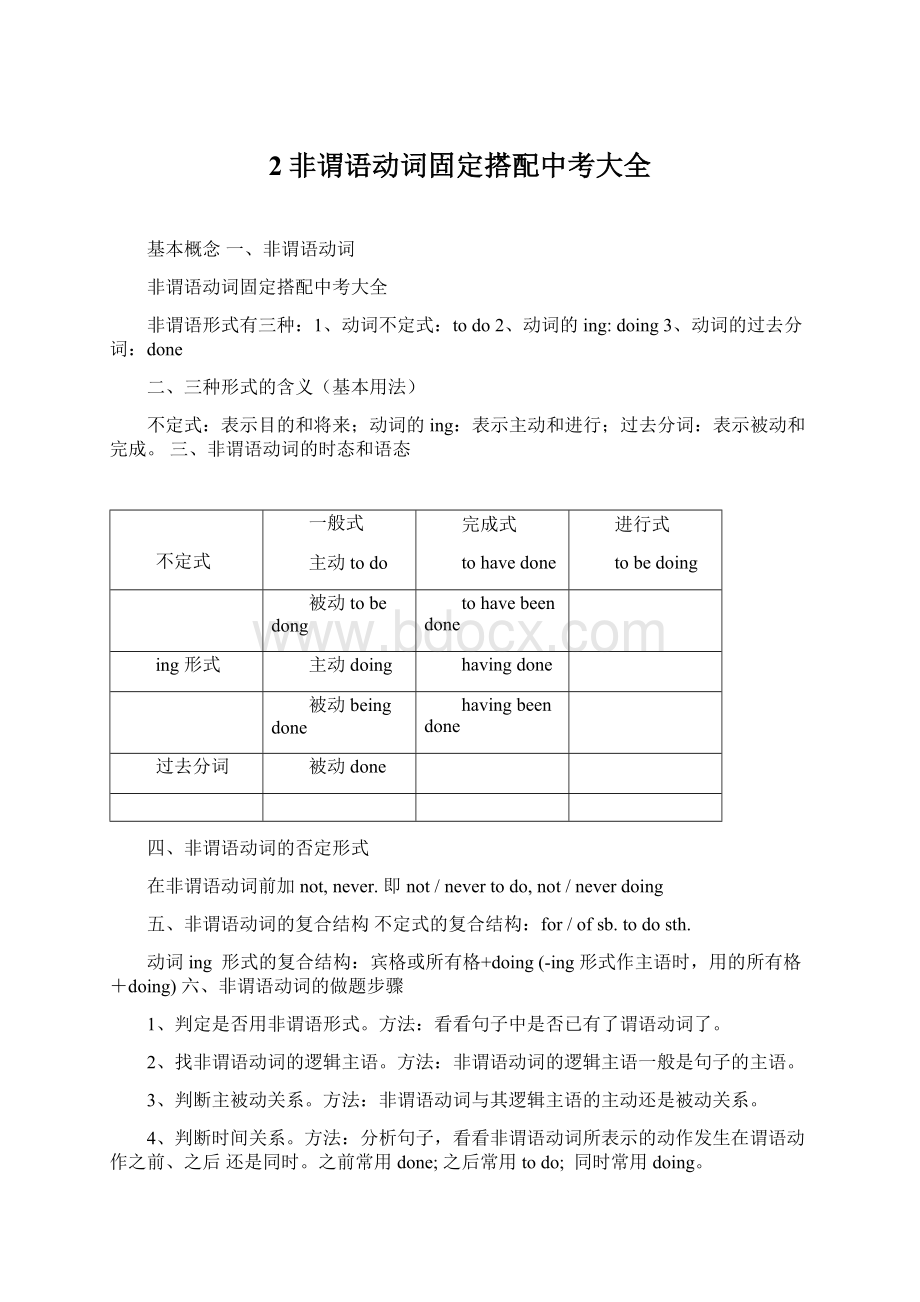2非谓语动词固定搭配中考大全.docx
《2非谓语动词固定搭配中考大全.docx》由会员分享,可在线阅读,更多相关《2非谓语动词固定搭配中考大全.docx(15页珍藏版)》请在冰豆网上搜索。

2非谓语动词固定搭配中考大全
基本概念一、非谓语动词
非谓语动词固定搭配中考大全
非谓语形式有三种:
1、动词不定式:
todo2、动词的ing:
doing3、动词的过去分词:
done
二、三种形式的含义(基本用法)
不定式:
表示目的和将来;动词的ing:
表示主动和进行;过去分词:
表示被动和完成。
三、非谓语动词的时态和语态
不定式
一般式
主动todo
完成式
tohavedone
进行式
tobedoing
被动tobedong
tohavebeendone
ing形式
主动doing
havingdone
被动beingdone
havingbeendone
过去分词
被动done
四、非谓语动词的否定形式
在非谓语动词前加not,never.即not/nevertodo,not/neverdoing
五、非谓语动词的复合结构不定式的复合结构:
for/ofsb.todosth.
动词ing形式的复合结构:
宾格或所有格+doing(-ing形式作主语时,用的所有格+doing)六、非谓语动词的做题步骤
1、判定是否用非谓语形式。
方法:
看看句子中是否已有了谓语动词了。
2、找非谓语动词的逻辑主语。
方法:
非谓语动词的逻辑主语一般是句子的主语。
3、判断主被动关系。
方法:
非谓语动词与其逻辑主语的主动还是被动关系。
4、判断时间关系。
方法:
分析句子,看看非谓语动词所表示的动作发生在谓语动作之前、之后还是同时。
之前常用done;之后常用todo;同时常用doing。
对比学习一、非谓语动词作主语和表语的比较1、不定式和动名词作主语和表语
a.不定式表示一次性的、具体的动词。
动词ing常表示一般的、泛指的或习惯性的动作。
如:
isagoodformofexerciseforbothyoungandold.
A.ThewalkB.WalkingC.TowalkD.Walkb.不定式作主语时,常用it作形式主语,即用句型:
Itis+adj./n.+(for/ofsb.)todosth.It’simportantforustolearnEnglishwell.It’skindofyoutohelpus.
2、不定式、动名词、分词作表语的比较
a、不定式、动名词作表语,.表示主语的内容。
如:
Myjobisteaching/toteachEnglish.
Knowingwhowearemeansknowingwhatweliketodo.b、分词作表语
一些表示情感、情绪的动词,常用分词形式作表语。
现在分词表示主语的性质特征,用过去分词表示主语的状态。
Themovieisexciting.Weareexcitedatthenews.
c、在seem/appear(似乎,好像),prove/turnout(被证明是),remain(仍然是,尚待)等连系动词后,可用不定式作表语。
Heseemed(tobe)veryhappy.
Havingatripabroadisgoodfortheoldcouple,butitremainswhethertheywillenjoyit.
二、不定式、动名词作宾语的比较
1、只能接不定式的动词:
a.(想要)want,wouldlike,wouldprefer,ask,demand,intend,desire,b.(希望)wish,hope,expect,
c.(决定)agree,decide,manage,promise,choose,continue,plan,prepare,makeupone’smind,tryone’sbest,offer,apply,
d.happen,learn,fail,pretend,refuse,afford2、只能接动名词的动词:
suggest,advise(建议),finish,mind(介意),enjoy(喜欢),appreciate(鉴赏,感激),forbid(禁止),avoid(避免),can’thelpdoing(忍不住),risk(冒险),feellike(想要),delay,putoff(推迟),giveup(放弃),bebusy(忙于),beworth(值得),practise(反复练习)
3、接不定式和接动名词意义不同的动词:
remembertodo记得去做rememberdoing记得做过
forgettodo忘记去做forgetdoing忘记做过了
regrettodo遗憾去做regretdoing后悔做过
trytodo设法去做trydoing试着做
goontodo接着做另一件事goondoing继续做同一件事,
meantodo打算做meandoing意味着做
stoptodo停下来去做stopdoing停止做
canthelp(to)do不能帮助做can’thelpdoing忍不住做。
练一练:
InsomepartsofLondon,missingabusmeansforanotherhour.
A.waitingB.towaitC.waitD.tobewaiting4、表示未实现的愿望的动词,即表示本打算、想做,但事实上没做
这些动词plan,intend,mean,want,hope,wish,expect,用hadplannedtodosth./plannedtohavedone来表示。
Wouldlike/love只用wouldliketohavedone
Iwouldlove
tothepartylastnightbutIhadtoworkextrahourstofinishthereport.
A.togoB.tohavegoneC.goingD.havinggone5、要接动名词的几个句型
prevent/stop/keepsb./sthfromdoing…(阻止…做)
spend/wastetime/moneyindoingsth.在…花费或浪费时间或钱
howabout/whataboutdoing
havesomedifficulty/trouble/problemsindoing在做…有困难haveahard/goodtimeindoing做…很艰难或做…很愉快Thereisnosense/pointindoing
6、含介词to的短语
lookforwardto盼望,devote…to致力于、献身于,be/getusedto习惯于,leadto导致,
getdownto着手做,payattentionto注意,referto谈到,所指,参考,equalto等于,能胜任,
belongto属于练一练:
MrReedmadeuphismindtodevoteallhehadtosomeschoolforpoorchildren.
A.setupB.settingupC.havesetupD.havingsetup7、介词but(除了)后接不定式:
havenochoicebuttodosth.没有别的选择只好做…但当but前有形为动词do时,but后的不定式省to.
练一练:
Sandycoulddonothingbuttohisteacherthathewaswrong.
A.admitB.admittedC.admittingD.toadmit
8.permit/allow(允许),advise(建议),forbid(禁止),有两种用法:
一是后接动名词,二是后接“sb.+todosth”
9、need,want,require意为“需要”,主语是物时,用句型:
need,want,require+doing用动词ing主动形式表被动意义三、不定式、现在分词、过去分词作宾语补足语的比较1、不定式作宾语补足语,如:
asksbtodosth(sb作宾语,todosth作宾补,宾语+宾补=复合宾语)类似动词有:
invite,tell,want,encourage,advise,order,requir,foce,beg,cause,allow,permit,forbid(禁止),warn(警告),remind,teach,callon(号召),
dependon(指望),wouldlike/love(想要),prefer,wish,expect,(hope不带复合宾语)注:
helpsb(to)dosth.
2、使役动词后接不带to的不定式
let/make/havesbdosth.但使役动词的被动语态常用:
bemadetodosth.
3、感官动词后作宾补的非谓语形式
感官动词:
feel,see,hear,watch,notice
句型:
感官动词+sb+do/doing/done(分别表示全过程、正在发生、被动完成)
1)Theyknewherverywell.Theyhadseenherupfromchildhood.
A.growB.grewC.wasgrowingD.togrow
2)Themissingboywaslastseenneartheriver.
A.playingB.tobeplayingC.playD.toplay
4、with的复合结构:
with+宾+宾补。
作宾补的词可以是:
形容词、副词(in,out),介词短语,非谓语形式)。
With的复合结构的宾补中的非谓语形式todo表示将来,doing表示主动和进行,done表示被动和完成。
Themurdererwasbroughtin,withhishandsbehindhisback.
A.beingtiedB.havingtiedC.tobetiedD.tied5、have句型:
havesbdosth,havesb/sthdoing,havesb/sthdone
havesthdone表示两种意义:
请别人做,而不是主语做;意外事故引起的。
Hedidn’tkeeponaskingmethetimeanylongerashehadhadhiswatch.
A.torepairB.repairedC.repairingD.repair
6、find+宾语+宾补(doing/done),keep+宾+doing,catchsb+doing(撞见某人在做),smellsb
+doing(察觉到某人在做)
Helookedaroundandcaughtamanhishandintothepocketofapassager.
A.putB.tobeputtingC.toputD.putting
7、表示“认为”的think,believe,consider,judge等,常用句型:
thinksb(tobe)+adj./n.,beconsideredtohavedonesth.被认为已做了某事
8、makeoneselfunderstood/heard/known,即用了过去分词作作宾补
9、句型Itissaid/reported/thought/knownthat….sb/sthbesaid/reportedtohavedonesth.
Robertissaidabroad,butIdon’tknowwhatcountryhestudiedin.
A.tohavestudiedB.tostudyC.tobestudyingD.tohavebeenstudying
四、不定式、现在分词、过去分词作状语的比较
1、不定式作目的、原因、结果状语a.作目的状语:
有三种形式,可互换:
todo,inordertodo,soastodo
b.原因:
不定式常放在表示情绪反应的形容词后。
如:
happy,sorry,glad,sad,surpried,disappointed.c.结果:
常用onlytodo…来表示末曾预料到或令人不快的情况,其动作发生在谓语动作之后。
另外固定结构:
too…todo,enoughtodo,so/such…astodo中,不定式也作结果状语d.在形容词后作状语,只用不定式
2、现在分词、过去分词可作时间、条件、让步、方式、原因、结果状语,就不作目的状语。
注:
表示时间、条件或让步的分词,有时可带上连词(if,unless,when,while,onc(e
一旦)though,although)
练一练:
time,he’llmakeafirst-classtennisplayer.
A.HavinggivenB.TogiveC.GivingD.Given
五、三种非谓语形式作定语定语的比较
1、不定式作定语常表示“用…要做”和“修饰the+序数词”。
常用句型:
have/therebe…/with+宾语+todo
2、分词作定语:
单个的分词作定语,放在被修饰的名词前,而分词短语常放在后面。
(1)TheymadeeffortstobringstolenculturalrelicsbacktoChina.(过去分词表被动和完成)
(2)Iwanttowriteaboutpeopleaddictedtodrugs.
asleepingboy(=);aswimmingpool(=)
fallingleaves(=);fallenleaves(=)3、tobedone,beingdone,done作定语的区别
六、几个特殊句式
1)Whynotdosth?
=Whydon’tyoudosth?
2)hadbetter(not)dosth.最好做
3)wouldrather(not)dosth.宁愿做4)wouddo…ratherthando…wouldratherdo…thando…
prefertodo….ratherthando…
preferdoing…todoing…宁愿做….而不愿做七、疑问词+不定式结构
1)what/whichtodo(what/which作do的逻辑宾语,what意为“什么”,which“表示选择”2)when/where/howtodosth.
3)whethertodosth.(不用if)
4)why(not)dosth.(why后省去to)“疑问词+不定式”在句中作主语或宾语八、特殊的独立结构1)现在分词的独立结构
judgingfrom/by…,generallyspeaking,strictlyspeaking2)不定式的独立结构
totellyouthetruth,tomakethingsworse,tobegin/startwith3)动词原形:
Believeitornot(信不信由你)
4)作连词的分词considering(考虑到,就…而言),providing/provided…假如,supposing假如这些词用来表示条件的连词,后接that从句。
九、不定式、动名词作主语时,谓语动词用第三人称单数。
十、我的重要笔记
1.stoptodosth.和stopdoingsth.
“stoptodosth.”表示停止做其它事情而去做“todosth.”所表示的事情,可以将“todosth.”理解成“stop”的目的状语;“stopdoingsth.”表示不做“doingsth.”所表示的事情。
例如:
“Stoptalking.Let’sbeginourclass.”saidtheteacher.老师说:
“别说话了,让我们开始上课。
”
Wehavekeptdoingourhomeworkforalongtime.Let’sstoptolistentomusic.我们做家庭作业很长时间了,让我们停下来听听音乐。
2.forgettodosth.和forgetdoingsth.(remembertodosth.和rememberdoingsth.)
“forgettodosth.”表示将来不要忘记做某事,谈的是未来的事情;“forgetdoingsth.”表示忘记过去应该做的事情。
例如:
“Don’tforgettodoyourhomework.”saidtheteacherbeforetheclasswasover.老师在下课前说:
“不要忘记做家庭作业。
”
“I’msorry.Iforgotdoingmyhomework.MayIhanditinthisafternoon,Mr.Chen?
”saidLiMing.李明说:
“对不起,我忘记做家庭作业了。
我今天下午交好吗,陈老师?
”
3.havesth.done.(过去分词)(让别人)做某事
例如:
Ihadmyhaircutyesterdayafternoon.我昨天下午理了发。
Mycomputercannotworknow.Imusthaveitrepaired.我的电脑有故障了,我必须让人修好它。
4.感官动词后接不带to的不定式或者现在分词的区别
例如:
seesb.dosth.看见某人(经常)做某事和seesb.doingsth.看见某人(正在)做某事Ioftenseehimdoexerciseinthemorning.我经常在早晨看见他锻炼身体。
WhenIwaswalkinginthepark,Isawhimdrawingapicturethere.当我在公园散步的时候,我看见他正在那里画画。
5.在主动语态中,感官动词(see,hear,feel,watch等)和使役动词(make,have,let等)要求接不带to的不定式做宾语补足语,而在被动语态里,不定式要带上to。
例如:
Thebossoftenmadetheworkerswork10hoursaday.Theworkersweremadetowork10hoursaday.
Shewasheardtousestronglanguage.听说她骂人了。
6.常用的几个和不定式有关的句型:
Whynotdosth?
为什么不做某事?
Ittakes/tooksb.sometimetodosth.做某事花了某人多长时间。
Itis/was+形容词+(forsb.)+todosth.做某事(对某人来说)怎么样。
7.介词后面一般接动名词。
要特别注意介词to和不定式符号to的区别
preferdoingsth.todoingsth.喜欢做……不喜欢做……lookforwardtodoingsth.期待/盼望做某事
makeacontributiontodoingsth.为……做出贡献8.现在分词和过去分词做定语的区别A.现在分词含有正在进行的意思,而过去分词含有被动或者已经完成的意思,如:
adevelopingcountry发展中国家adevelopedcountry发达国家
boilingwater正在沸腾的水(一般情况下水温为100℃)boiledwater开水(已经烧开的水,水温可以依然很高,也可以是凉白开)
aboynamedJim一个叫Jim的男孩B.有些动词的现在分词和过去分词都具有形容词特征,但是它们的意思有区别。
它们的-ing形式往往用来说明事物的特征;他们的-ed形式表示被动的意思,用来说明人的情况。
Iaminterestedinthisinterestingstory.我对这个有趣的故事感兴趣。
Iammovedatthemovingsight.我被这动人的情景感动了。
Theywereamazedattheamazingfacts.他们对那些令人惊异的事实感到惊奇。
常见固定表达
和todo连用的固定搭配
asksb.todosth.请求某人做某事bepleased/begladtodosth.很高兴做某事can'twaittodosth.迫不及待地做某事can'taffordtodosth.不能担负起干某事decidetodosth.决定做某事do/tryone'sbesttodosth.尽全力做某事
donothingtodosth.对……无能为力deservetodosth.值得干某事形容词/副词+enoughtodosth.足以做某事encouragesb.todosth.鼓励某人做某事find+it+形容词+todosth.发现做某事…getreadytodosth.准备做某事
goontodosth.继续做某事hopetodo